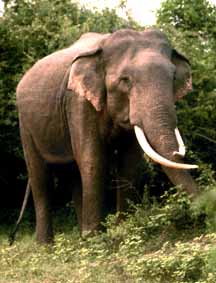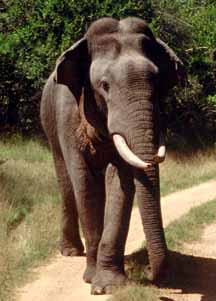
Hermese (After Lal Anthonis)
Crossed tuskers of Yala
by Sunil Senerath Banda Rambukpotha
 Hermese (After Lal Anthonis) |
DN Sat Jun 7 2003: Crossed Tuskers popularly known as Dala Pootuwas, have been the main attraction of the Ruhunu National Park for decades. it is the wish of everybody to spot one of them when they enter the park.
It is an amazing fact that these crossed tuskers have been seen only in Yala and nowhere else. May it be a genetic factor or conditional reason these crossed tuskers have been seen only in this park. The sighting of a tusker did not come that easy and was a rare sight at one time.
Since I saw my first tusker on the Wellawaya - Tanamalwila road as a schoolboy in the 1960s, I waited almost thirteen long years to see the next at Lahugala. Since then my luck changed, I saw my first crossed tusker in the same year at Yala. In full musth and prime of its youth Podi Pootuwa was a magnificent site indeed.
Today the trend has changed, a three day stay in Yala with a bit of luck you encounter a Tusker or two. Is it that the population of Tuskers is on the increase or is it that they are moving into the protected areas and do not migrate as usual. There is no doubt, that unplanned jungle clearing for chena cultivation, human settlements on elephant corridors have restricted the natural habitats. This may be the most likely reason for the increase of tusker recordings in Yala and even in other National parks. More than a dozen were recorded in the Handapanagala herds before the controversial elephant drive, but never a crossed one. In Yala, they have appeared from time to time. Some keen wildlife enthusiasts have observed about six of them since the Walaskema tusker in the 1960s.
The Walaskema Pootuwa
The Walaskema Pootuwa attracted the attention of many wildlife photographers of that time. Max Hemple and W.R. Wijesoma took some price winning pictures of this tusker. A beautiful portrait taken by Hemple while the tusker was drinking off Walaskema, hung on the walls of the Yala circuit bungalow. It is a shame that these priceless pictures had to turn to ashes when this bungalow was attacked and burnt down.
The tusker itself had a tragic end. It went missing in the early 70's and later it was discovered to have died of gunshot injuries.
In the 1970s two other tuskers popularly known as Maha Pootuwa and Podi Pootuwa roamed the park. They seemed to have posed for many photographers. Some excellent shots of these two came from Lal Anthonis' collection. His monochrome of the senior in full charge won him the Pat Decker Memorial Award for the best wildlife picture at the fourth festival of wildlife photography held in respect for the visit of His Royal Highness the Duke of Edinghborough who was the chief guest. Another of Podi Pootuwa adorns a full page of the APA insight guide to Sri Lanka. Anthonis has also done a comprehensive study on these tuskers during his long stays in Yala. He himself has recorded five of them excluding the Walaskema tusker, which he said, never had a change to see.
I consider myself lucky to have been with him on some occasions during his study. We have shared some thrilling experiences during this time. At Yala in November 1989, Lal and I set off on an after breakfast drive towards Vilapalawewa from the Mahaseelawa bungalow. On the main road between the wewa and Kudaseelawa Mahapootuwa suddenly broke cover and came on to the road. With out hesitation it started a brisk walk from a distance of about 800 yards towards us. As it got closer, it suddenly stopped for a few seconds. Increasing its speed it came briskly towards us.
A few yards away from us the beast stopped again, went down on its feet and lay down on the road in a sleeping position. Then it got up half way and had a good stare at us with cocked up ears and scented the air. rising back to its feet it stood right in front of us and held us up for a good fifteen minutes.
 Pellets (After Lal Anthonis) |
During these tense moments it remained fully alert and continued staring and scenting the air. Suddenly its attention was diverted towards a trumpeting from a herd quite a distance away in the jungle. The tusker turned around, returned the call and walked away towards them. Mahapootuwa had been spotted later at its favourite habitat the Buttuwa Plains quite often, but suddenly went missing in the early 1990s. The authorities of Yala believe it's dead, but the reason or location is unknown.
Podipootuwa's fate was a very sad story. 1984 October, the park was very dry and brown except for the evergreen Mallittan. Lal and I set off on a mid afternoon drive from the Yala bungalow. Just past Padikema we saw Podipootuwa walking briskly towards Meynart Tank. We drove upto the waterhole, which had lost even its last drop of water. The angry tusker finding no water turned and came straight at our vehicle. It stood a few yards away from us and left us no chance of a movement until it cleared its doubts. Dead silence prevailed over the area except an occasional click from one of our cameras. The tusker suddenly turned and walked towards buttuwa wewa, which sustained a fair volume of water.
A few weeks later the message of tusker being shot at Yala was going around. The officials with the help of clues got from villagers discovered that a half burnt carcass was lying off Godekalapuwa in the western borders of the park. Its molars had been axed and the tusks removed, after it succumbed to shots off a short barreled muscle loader. With the tireless efforts of a police officer the investigation team established beyond doubt that it was the end of Podipootuwa. The police officer, now in a top-rank arrested the culprits and brought them to justice but the result ultimately was that another magnificent tusker was gone.
Bedi Some was a native of the Kumuna village. He made friends with a lot of people who visited Yala. One afternoon I met him on the banks of the Menik making his way to block 1. I asked him about the Pootuwas and he told me the tragic story of the famous Walaskema pootuwa.
A wealthy Colombo businessman had contracted a cattle keeper of Kumana to shoot the tusker for its ivory. He had been dreaming of these magnificent tusks adorning the hall of his luxurious house. Curse came upon both of them. The cattle keeper's herd acquired a deadly disease and died one by one. The man himself had lost his only income and lived a hard life until he died of snakebite. The main culprit had suffered and died of a prolonged cancer.
So went three of the magnificent crossed tuskers. But they have kept on appearing from time to time; according to Anthonis there are at least three other crossed tuskers in the park. But the main task now remains with all the wildlife enthusiasts to assist the authorities to protect these treasures of the jungle.